Commodities: New Year's Promises Vs. Elliott Wave Patterns
Commodities / Commodities Trading Jan 03, 2017 - 08:07 PM GMTBy: EWI
 2011, 2014, and 2016: The year's performance has consistently followed its Elliott wave script
2011, 2014, and 2016: The year's performance has consistently followed its Elliott wave script
It's that time of year again, when before us an entirely new blank slate is laid, which we eagerly fill with promises of better health, habits, and life choices.
But, according to Statisticsbrain.com, only 8% of people successfully carry through with their New Year's resolutions -- or as I like to call them, Maybe-lutions.
It reminds me of the frequent promises made by the mainstream finance regarding the future of specific markets -- and how so many of those promises go unfulfilled.
Take, for example, commodities. In the last five years, the popular pundits twice resolved that commodities would make a comeback. And twice the sector failed to fill the bullish bill.
The first instance was in 2011. At the time, the bellwether Thomson Reuters/Jefferies CRB Index stood at its highest level in two years, while commodity exchange traded funds experienced their highest ever inflow on record.
According to the news-focused analysts, commodities as a whole had resolved to quit their bear habits in 2011, and soar:
- "The bull market in commodities is likely to continue for some time." (Dec. 8, 2010, Wall Street Journal)
- "The crash of 2008 in commodities was a mere blip... The rally in prices shows no signs of slowing." (March 9, 2010, National Post)
- "All of the elements that contributed to the long bull run in commodities from October 2001 to August 2008 are in place." (Jan. 6, 2011, The Telegraph)
From the perspective of our January 2011 Elliott Wave Theorist, however, "all of the elements" were in place for a re-commitment to the downside:
"The current juncture in ... commodities markets is the flip side of early March 2009... Now we have a completed counter-trend Elliott wave structure (three waves up), extreme bullishness among all types of investors, blatantly diminishing upside momentum, and (according to the majority of economists) bullish fundamentals. This year should begin a multi-year period of outsized gains for those on the short side."
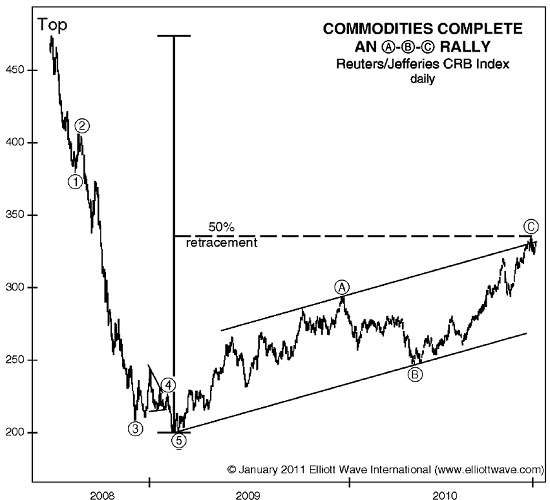
In the months that followed, the "worst raw materials slump since 2008" sent everyone from individual investors to behemoth investment banks to the commodity exits. From its April 2011 high, the CRB Index turned down in 20%-plus, three-year long bear market.
The second instance was more recent, in early 2014. At the time, the natural resources sector had gone from asset class laggard to leader. This was not about to change, according to some experts:
"Why This Year Could Be the Year of the Commodities Comeback... The biggest problem commodities had over the past year and a half or so is that there's been spotty growth in the world. You look now and that's a very different environment. We have the most synchronized global growth outlook here going into 2014 that we've ever had." -- Jan. 7, 2014, CNBC
Once again, however, Elliott wave analysis and market sentiment saw what the mainstream could not: a perfect set up for a reversal. Here, the April 2014 Elliott Wave Financial Forecast set the scene:
"The top graph shows that Large Speculators' (the trend-following hedge funds) net-long position from the weekly Commitment of Traders report. The CRB index is at a lower high than its July 2008 peak, its May 2011 countertrend high, and its September 2012 high, yet Large Specs hold a record net-long position in futures and options contracts.
"The bottom graph shows that the Daily Sentiment Index (trade-futures.com) on February 20 jumped to 95% bulls, the highest percentage since June 18, 2008. That was right before the all-time price peak in the CRB Index.
"Either extreme would be enough to suggest a significant commodity decline, but both in tandem signify that something important is about to happen, namely a collapse in commodity prices."
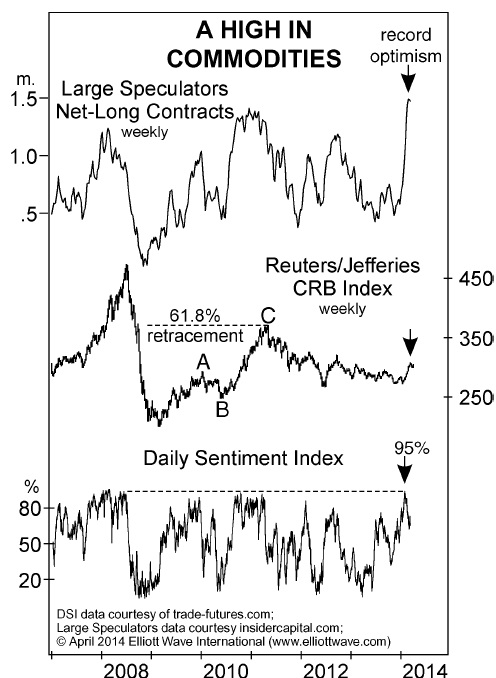
In the months to follow, commodity prices were again slashed by 20%. The sector ended the year with its biggest annual decline since the "global financial crisis in 2008," and with its longest consecutive yearly loss since 1991. (Bloomberg)
By the end of 2015, the raw materials slaughter went from bad to worse:
- The Thomson Reuters/Jefferies CRB Commodity Index stood at 13-year low
- The Bloomberg Commodity Index plunged to its lowest since its inception in 1991
- "Assets under management in the top 10 commodities funds plunged 80% since 2008."
- Hedge funds managers held their largest net bearish position on record, according to U.S. Commodity Futures Trading Commission
And, according to many mainstream experts, commodities would fulfill one main resolution for 2016: Keep Falling!
Wrote these headlines from the time:
- "There's more pain ahead for commodities. The meltdown isn't over yet." (Bloomberg, Jan. 17)
- "There's fear in the marketplace. There's not a lot of places where you can put your money right now. Short commodities is a pretty good one." (Bloomberg, Jan. 17)
- "The commodities hangover, the dark side of a decade's long boom, could last for a while." (Economic Times, Jan. 11)
- "Markets, whether for oil or for metals or minerals, will be characterized by surplus supplies and relatively depressed prices for some time to come." (Financial Times, Dec. 22)
Once again, the objective insight of Elliott wave analysis provided an altogether unique perspective -- one of great upside potential for commodities.
In our December 2015 Monthly Commodity Junctures, senior analyst Jeffrey Kennedy identified a mature, five-wave decline on the CRB Index's daily price chart. By the rules and guidelines of Elliott wave analysis, the battered sector was set to enjoy a powerful comeback:
"I think the entire commodity complex as a group is at a pivotal juncture...and we're very near completion of move to the downside [which began in 2010].
"So the bottom line I think 2016 is going to be a very exciting year for anyone who invests in commodities. As we move into the first quarter of 2016, I'm going to be looking for significant lows to form."
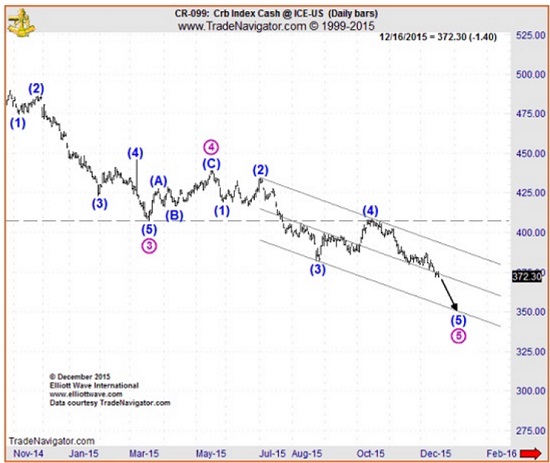
As 2016 kicked off, so with it a rising trend in the CRB. By March, our Monthly Commodity Junctures confirmed the conclusion of the five-wave decline and onset of a significant rise in this labeled price chart:
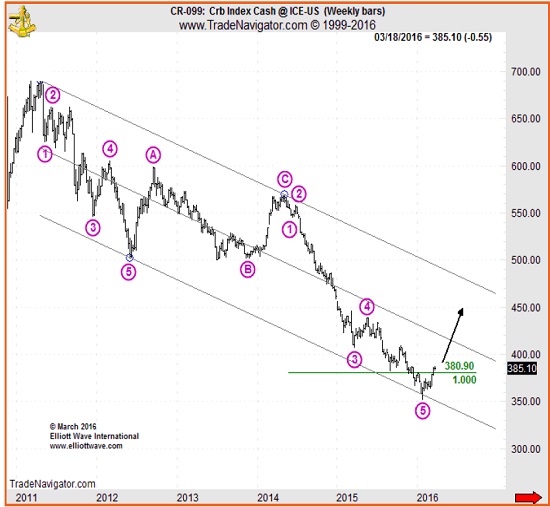
From there, commodities broke out of their bearish coils and embarked on a powerful rally to one-year highs, with the Bloomberg Commodity Index poised for its first annual advance since 2010.
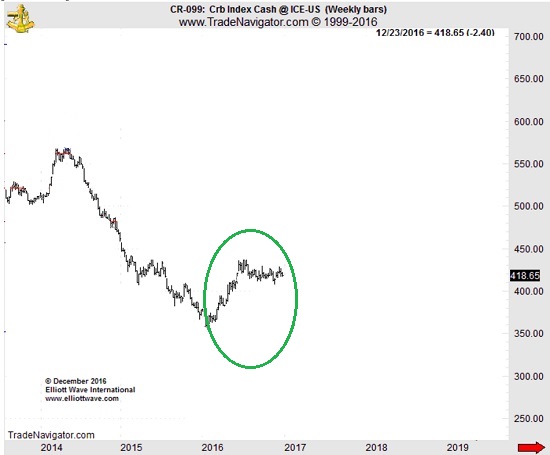
Whether the broad raw materials sector is set to turn over a new bullish leaf in 2017 -- well, that's not always a matter of mainstream promises. In recent years, it's been a matter of the Elliott wave pattern.
Free eBook: Commodity Traders ClassroomGet 32 pages of actionable trading lessons, hand-selected by EWI Chief Commodity Analyst Jeffrey Kennedy, designed to make you a better trader. |
This article was syndicated by Elliott Wave International and was originally published under the headline Commodities: New Year's Promises Vs. Elliott Wave Patterns. EWI is the world's largest market forecasting firm. Its staff of full-time analysts led by Chartered Market Technician Robert Prechter provides 24-hour-a-day market analysis to institutional and private investors around the world.
About the Publisher, Elliott Wave International
Founded in 1979 by Robert R. Prechter Jr., Elliott Wave International (EWI) is the world's largest market forecasting firm. Its staff of full-time analysts provides 24-hour-a-day market analysis to institutional and private investors around the world.
© 2005-2022 http://www.MarketOracle.co.uk - The Market Oracle is a FREE Daily Financial Markets Analysis & Forecasting online publication.



